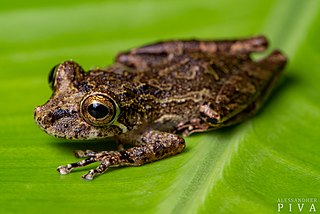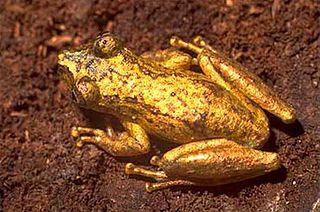
The wallum sedge frog, also known as the Olongburra frog or the sharp-snouted reed frog, is a species of frog that is endemic to Australia. Varying in color from brown to dark green it inhabits the thick and often acidic marshes of the Wallum along the coast of Queensland and New South Wales. Mating season comes in early spring, often after heavy rainfalls. Females attach their eggs to grasses and sedges. Their call is high pitched and follows a "creeeek... crik" pattern.
Ololygon agilis, commonly known as the agile snouted treefrog, is a species of frog in the family Hylidae. It is endemic to Brazil, where it occurs along parts of the eastern coast.
Ololygon alcatraz is a species of frog in the family Hylidae. It is endemic to Ilha dos Alcatrazes, an island off the coast of São Paulo state, Brazil. Common name Alcatraz snouted Treefrog has been coined for it.

Ololygon argyreornatus, commonly known as the Rio Mutum snouted treefrog, is a species of frog in the family Hylidae endemic to Brazil. Its natural habitats are subtropical or tropical moist lowland forests, subtropical or tropical moist montane forests, subtropical or tropical moist shrubland, freshwater marshes, intermittent freshwater marshes, and heavily degraded former forests. It is threatened by habitat loss.
Ololygon aromothyella is a species of frog in the family Hylidae, found in Argentina, Uruguay and Brazil.
Ololygon brieni is a species of frogs in the family Hylidae.

Ololygon carnevallii is a species of frog in the family Hylidae.

Ololygon catharinae is a species of frog in the family Hylidae. It is endemic to Brazil. Its natural habitats are subtropical or tropical moist lowland forests, subtropical or tropical moist montane forests, rivers, freshwater marshes, and intermittent freshwater marshes. It is threatened by habitat loss.
Ololygon centralis is a species of frog in the family Hylidae. It is endemic to Brazil. Its natural habitats are subtropical or tropical dry forests, moist savanna, subtropical or tropical moist shrubland, rivers, and intermittent freshwater marshes. It is threatened by habitat loss.
Ololygon heyeri is a species of frog in the family Hylidae. It is endemic to Brazil. Its natural habitats are subtropical or tropical moist lowland forests and rivers. It is threatened by habitat loss.

Ololygon hiemalis is a species of frog in the family Hylidae. It is endemic to Brazil. Its natural habitats are subtropical or tropical moist lowland forests, rivers, and freshwater marshes. It is threatened by habitat loss.
Ololygon humilis, also known as the Rio Babi snouted treefrog, is a species of frog in the family Hylidae. It is endemic to the coastal lowlands of Rio de Janeiro in southeastern Brazil, as well as Espírito Santo and São Paulo.
Ololygon jureia is a species of frog in the family Hylidae. It is endemic to Brazil. Its natural habitats are subtropical or tropical moist lowland forests and intermittent freshwater marshes. It is threatened by habitat loss. It takes its name from the Juréia Massif in the Juréia-Itatins Ecological Station, where it has been found.

Ololygon littoralis is a species of frog in the family Hylidae. It is endemic to Brazil. Its natural habitats are subtropical or tropical moist lowland forests and intermittent freshwater marshes. It is threatened by habitat loss.
Ololygon luizotavioi is a species of frog in the family Hylidae. It is endemic to Brazil.

Ololygon rizibilis is a species of frog in the family Hylidae. It is endemic to Brazil. Its natural habitats are subtropical or tropical moist lowland forests and intermittent freshwater marshes. It is threatened by habitat loss.

Ololygon trapicheiroi is a species of frog in the family Hylidae. It is endemic to Brazil. Its natural habitats are subtropical or tropical moist lowland forests and rivers. It is threatened by habitat loss.
The Nyonga forest tree frog is a species of frog in the family Arthroleptidae endemic to the Democratic Republic of the Congo. Its natural habitats are rivers, freshwater marshes, and intermittent freshwater marshes. As of 2004, the Upemba National Park was the only place in which they were being protected.

The Central Asiatic frog, or Asian frog, is a species of true frog, found in China, Kazakhstan, and Kyrgyzstan. Its natural habitats are temperate forests, temperate shrubland, temperate grassland, rivers, intermittent rivers, swamps, freshwater lakes, intermittent freshwater lakes, freshwater marshes, intermittent freshwater marshes, freshwater springs, inland deltas, arable land, pastureland, rural gardens, urban areas, water storage areas, ponds, aquaculture ponds, and irrigated land. It is not considered threatened by the IUCN.

Ololygon is a genus of frogs in the family Hylidae. The majority of species in it are endemic to the Atlantic Forest of eastern Brazil, although the range of some species, including Ololygon aromothyella and Ololygon berthae, is known to extend south to northeastern Argentina, southern Paraguay, and Uruguay.










